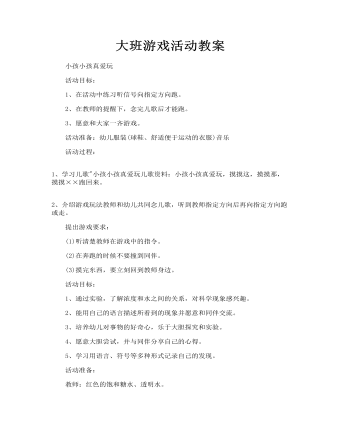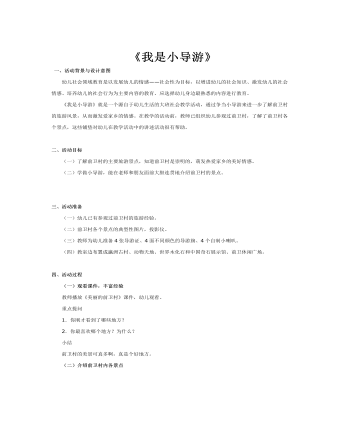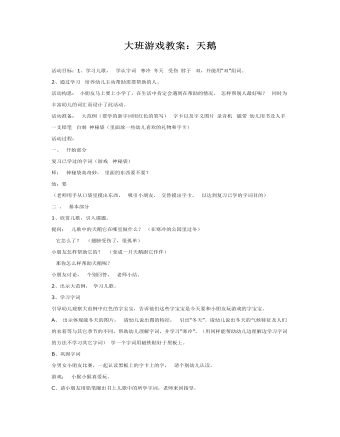-

大班游戏活动教案
1、学习儿歌"小孩小孩真爱玩儿歌资料:小孩小孩真爱玩,摸摸这,摸摸那,摸摸××跑回来。 2、介绍游戏玩法教师和幼儿共同念儿歌,听到教师指定方向后再向指定方向跑或走。 提出游戏要求: (1)听清楚教师在游戏中的指令。 (2)在奔跑的时候不要撞到同伴。 (3)摸完东西,要立刻回到教师身边。

大班社会教案:我是小导游
二、活动目标 (一)了解前卫村的主要旅游景点,知道前卫村是崇明的,萌发热爱家乡的美好情感。 (二)学做小导游,能在老师和朋友面前大胆连贯地介绍前卫村的景点。 三、活动准备 (一)幼儿已有参观过前卫村的旅游经验。 (二)前卫村各个景点的典型性图片,投影仪。 (三)教师为幼儿准备4张导游证、4面不同颜色的导游旗、4个自制小喇叭。 (四)教室边布置成瀛洲古村、动物天地、世界木化石和中国奇石展示馆、前卫休闲广场。

大班游戏教案:赛龙舟
活动过程:一、幼儿自由结伴尝试下列游戏:1、两人从两边同时走上独木桥,怎样才能走过小桥,且自己和对方不被挤到桥下。2、两人拿一张有洞的报纸,将身体套入报纸中,变成一个“连体人”一起向前跑,尽量不让报纸撕开。3、两人一起用身体任何一部位(除了手)拿住球向前行进,球不掉下来。二、幼儿和教师一起讨论:1、你们是怎样玩的?成功吗?怎样做能成功?2、师小结:玩这些游戏时最好事先商量好办法,玩时两人要密切配合,这样才能成功。

大班游戏教案:玩陀螺
二.活动准备:1、每张桌子上的筐内有小陀螺 2、幼儿人手一份: 1号盒中形状不同的小陀螺; 2号盒中转动盘不同的小陀螺; 3号盒中轴不同的小陀螺。 三.活动过程(一)导入主题:师:小朋友,你们平时喜欢玩陀螺吗?那你们谁的陀螺赢了?你的陀螺是怎样赢得?(二)操作探索11.①今天老师为你们准备了各种各样的陀螺,请你们一起来玩好吗?先请小朋友玩1号盒中的小陀螺,我们再来比一比,谁的陀螺转的时间长。②幼儿玩陀螺,教师巡回指导,鼓励幼儿大胆地比。③交流反馈。提问:你跟谁比了?陀螺成绩如何?为什么会比他的快(慢)呢?④验证。你们再来比一比,看看到底为什么?⑤师生共同小结:陀螺旋转的时间长短与陀螺的形状有关系。

大班游戏教案:翻翻棋
2.提高孩子的记忆力及综合分析能力。准备:1.棋盘一张。 2.25张用硬纸片做的棋子(稍小于棋盘格子),分别写有汉字。其中水果类5张,如:梨、苹果、桃、杏、西瓜;干果类5张,如栗子、核桃、枣、花生、榛子;蔬菜类5张,如白菜、土豆、茄子、辣椒、黄瓜;农作物5张,如玉米、小麦、高梁、水稻、大豆。另外5张不写字。玩法:1.将棋子字朝下,打乱摆放在棋盘的粗格子里,4位幼儿分别站在棋盘的一方,每人认一类棋子。(如甲找水果、乙找干果、丙找蔬菜、丁找农作物)。

大班游戏教案:捞宝贝
(二)活动准备:1、幼儿已能识辨可回收物品与不可回收物品2、小呼啦圈若干个、篓子若干个3、废旧物品(易拉罐、废纸盒、塑料瓶等)(三)活动过程:1、将幼儿分成人数相等的两组,分别站在各自的起跑线。2、教师示意开始,两组的第一名幼儿跳圈到终点(遇单圈时单脚跳,遇双圈时双脚分开同时跳)。

大班游戏教案:天鹅
一、 开始部分复习已学过的字词(游戏 神秘袋)师: 神秘袋真奇妙,里面的东西要不要?幼:要(老师用手从口袋里摸出东西, 吸引小朋友,交替摸出字卡, 以达到复习已学的字词目的)二、 基本部分1、欣赏儿歌,引入课题。提问: 儿歌中的天鹅它在哪里做什么?(在寒冷的公园里过冬) 它怎么了? (翅膀受伤了,很孤单)小朋友怎样帮助它的? (变成一只天鹅跟它作伴) 那你怎么样帮助天鹅呢?小朋友讨论, 个别回答, 老师小结。2、出示大范例,学习儿歌。

大班游戏教案:动物乐园
2、发展幼儿扩散思维,让幼儿初步接触更多会飞、会跳、会爬、会游的动物名称。活动准备:大盒子一个、小盒子数个(中间挖有一个洞);大、小字卡(大的一份、小的数份):小鸟、小兔、小虫、小鱼、飞、跳、爬、游;磁铁黑板;各种各样动物图片或动物字卡(与幼儿人数相同)活动过程:1、复习导入 教师拿出一个盒子(事先已将字卡“小鸟”、“小兔”、“小虫”、“小鱼”放入,让个别幼儿进行摸摸看的游戏,摸出来后,该幼儿要说出这是什么词?若说对,全体幼儿齐声说:“对、对、对,这是XX。”帮助幼儿进行小鸟、小兔、小虫、小鱼等几个动物词的认读复习。

大班体育教案:长凳游戏
活动准备: 木制长凳8条、海棉垫2块、塑料弧形积木8个、录音机、磁带。 活动过程: 1 幼儿进场,四散站立;在音乐伴奏下师生一起做热身操。 2 教师把活动器材 - 长凳介绍给幼儿:"长凳是用来坐的,可今天我们要用长凳做各种有趣的活动。"激发幼儿活动的兴趣。 3 鼓励幼儿自由探索长凳的各种玩法,并及时请幼儿示范自己的玩法。 4 带领幼儿进行各种钻爬游戏。 ①爬过"地道"--长凳横向间隔2米左右摆成一排,从长凳下爬过。 ②钻过双层"地道"--将长凳两个两个叠起来,从凳子间隙中爬过。 ③爬过"暗道"--将长凳并拢,从长凳下爬过后站到凳子上。 ④开"火车"--将长凳横向间隔0.5米左右摆成一排,请幼儿肩搭肩从长凳上迂回走过。 5 过"桥"游戏 让幼儿自我选择从纵向放置的一个长凳、两个并排的长凳、两个并排但左右分开的长凳上用各种方法走过"桥"。然后从一旁的塑料弧形积木拼成的"弯曲桥"上走回来。 6 将两个长凳叠在一起,让幼儿走过桥,从桥上跳下。然后从塑料弧形积木拼成的"弯曲桥"上走回来。 7 教师将幼儿集中起来,示范从桥上往下跳的正确姿势,讲解方法和要领:屈膝摆臂向上跳,前脚掌着地,屈膝缓冲,身体下蹲。然后幼儿继续练习。 8 将三个长凳叠起来并铺好海棉垫,让幼儿自己爬上凳子走过"桥"并从"桥"上跳到垫子上。然后从一旁的塑料弧形积木拼成的"起伏桥"上走回来。 9 视幼儿情况逐渐增加"桥"的高度,鼓励幼儿尝试从桥上走过并跳下。 注意事项: ①保持场地中有不同高度的"桥",让幼儿自己选择。 ②教师加强保护,尤其要注意过最高的"桥"幼儿的安全。 (可让配班教师协助保护。) ③引导幼儿帮助爬不上凳子的同伴。 ④对能力特别强的幼儿,教师可在其过"桥"时把手伸在桥当中设置障碍,让他跨过。 10 对幼儿的表现作积极的评价,表扬幼儿的勇敢精神和互相帮助的良好品质。 11 幼儿四散站立,在音乐伴奏下跟老师做放松操。 12 幼儿离场。

人教版新目标初中英语七年级上册Can you play the guitar教案
本单元主要是学习情态动词can的肯定句、否定句、一般疑问句,肯定与否定回答,以及特殊疑问句的构成和用法;复习what弓!导的特殊疑问句。本单元主要围绕“加人俱乐部,谈论自己的能力”这一话题,设计了三个任务型活动:任务一是:自己的才艺表演,学习情态动词can的用法;任务二是:自己建立俱乐部,运用情态动词can谈论自己在某一方面的能力、喜好和意愿;任务三是:我能成功,主要是复习巩固谈论各自的爱好和特长的方法。单元知识系统(树)Can you/he/she/you dance? 一Yes,I/he/she/we can./No,I/he/she/we can’t.Can Bill play the guitar?一Yes,he can,but he can’t sing.单元总体目标通过学习情态动词can的用法,使学生能够表达自己在某一方面所具备的才能;能够谈论自己的喜好与意愿;能够为自己成立的各种俱乐部制作海报;会写招聘广告。单元重难点一览重点 难点I.复习词汇:can,play,want2.词汇:guitar, dance, swim,sing, chess, speak, drum,trumpet,violin,play the guitar3.句型:Can you/he/she/you dance?Yes,I/he/she/we can./No,I/he/she/we can’t.Can Bill play the guitar?

人教版新目标初中英语七年级上册My favorite subject is science教案
本单元主要学习一周中星期一到星期天的表达方式;掌握学科的表达;学习用because和表示品质的形容词表示理由;学习what,why,who引导的特殊疑问句。本单元围绕“谈论自己所喜欢的学科”这一话题,设计了三个任务型活动:任务一是:谈论自己所喜欢的学科,学习what引导的特殊疑问句和学科的表达;任务二是:一分钟演讲,让学生介绍自己喜欢某一学科的理由,学习why等特殊疑问句;任务三是:写信,巩固和延伸所学知识,掌握星期的表达方式。单元知识系统(树)What’s your/his/her favorite subject? My/His/Her favorite subject is English.Why do you like math. Because it’s interesting.Why does he/she like art? Because it’s fun.When do you have math? I have math 0n Monday,Wednesday and Friday.What’s Ken’s favorite subject? Science.单元总体目标通过本单元的学习使学生学会谈论自己喜好的学科或自己喜好的其它事情并给出理由;学会说出一周的七天;学会合理地安排自己的作息时间。

人教版新目标初中英语七年级下册How was your weekend教案2篇
Teaching Goal:1. General aims:Talk about recent past events2. Particular aims:A. Language Focus.Talk about recent past events and think of the past events.B. Language goalsHow was….?It was …What did …do over the weekend?C. Language structures:(1). How was your weekend? I was great. Pay attention to no form.(2). What did you do over the weekend? I played soccer. We went to the beach.D. Useful words and phrases:Words: was, did, went, beach, over, project, test, wasn’t, false, number, geography, spend, week, most, mixture, their, had, little, cook, read, saw, change, everyone, sit, sat, no, anythingPhrases: did one’s homework, played soccer, cleaned my room, went to the beach, played tennis, went to the movies, on Saturday morning, over the weekend, cook … for, what about, do some reading, have a party, talk show, go shoppingE. Grammar language:Present simple past tenseRegular and irregular verbsF. Learning strategies:Tour and holidaysG. Interdiscipinary:H. Emotion and manner:Teaching time: 5 periodsTeaching procedures:Period One教学步骤、时间 教师活动 学生活动 媒体应用Step 1Free talk 3’ Ask some questions like:Who’s on duty today?What’s the weather like? Answer and talk about something.让同学们回答下列问题1. Do you like weekend? (Let some students answer)It takes them three minutes to talk about the question.2. Why do you like weekend? (let the students answer) Most of the students like the weekend此时教师用汉语问:“在周末期间问你干了什么?这句话用英语这么回答?Let the students guess.At last the teacher give them right answer3. What did you do over the weekend?(板书、学习)

人教版新目标初中英语七年级下册Where is the post office教案2篇
Period 2 (3a----Section B 2c)Preview(Pre-task): Key points: What laAdd another information about their pen pals----their language on the cardnguage does she/he speak?She/He speaks....Does she/he have any brothers and sisters? Does she/he speak English?Preview(Pre-task): Add another information about their pen pals----their language on the cardKey points: What language does she/he speak?She/He speaks....Does she/he have any brothers and sisters? Does she/he speak English?Step 1 Revision1.Revisionand dictation of the new words 2.Revise the drills they learned yesterday.(by pairwork and grammar exercise)Step 2 Leading-inT has a conversation with one student. The conversation is following:---Do you have a pen pal?---Yes, I do.---What's your pen pal's name? ---His/Her name is....---Where is your pen pal from? ---He/She is from...---Where does he/she live? ---He/She lives in....---What language does he/she speak?He/She speaks...Write the new words on the Bb. They are following: EnglishChineseJapaneseFrenchStep 3 LearnLearn the new words with the whole class.Finish 3a with the students3b Pairwork T still does an example with one student Then the Ss practise in pairs. The example is following:--Curry Muray is my pen pal. He is from the United States.---What language does he speak?

人教版新目标初中英语七年级下册I want to be an actor教案2篇
三、教学建议第一课时:1. Lead in (Vocabulary)A) Before class, teacher should collect some pictures of working places. For example: Bank, TV Station, Restaurant, Police Station, Hospital ...B) In class, show students the pictures (PowerPoint, OHP). Ask students to tell the name of the working places and the name of the jobs.Shop assistant, doctor, actor, reporter, police office, waiter, bank clerk, studentC) Do exercise 1a and 3a.2. Bingo GameAsk groups of students to make up pairs of cards with a job on one and the related workplace on the other. For example, waiter / restaurant, teacher / school, doctor / hospital. Encourage students to use both the job / workplace combinations in the book and the ones that students came up during class discussions. Be sure they have twice as many sets of cards as there are students in the group. They can make two sets of cards for a single job / workplace, if necessary. Then have each group mix up its set of cards and hand their cards out in random order. Each time a student gets a pair of cards that match, he or she can lay these cards down. The goal is to have no cards in your hand at the end.3. Task OneA) Ask students to work in pairs and ask the partner what does he / she want to be in the future.e. g. :What do you / does he / does she want to be?I want to be a.Why?Because it's (adj).B) Vocabulary: Section B, 1a4. Homework 1.2.

人教版新目标初中英语七年级下册Where is your pen pal from教案
2.1Match the country with the language.Step II Reading3a? let the students read the letter fast and answer the questions.? Let the students ask more questions about the letter as possible as the can.Step III Writing3b.Step IV. Pairwork2cStep V Listening2a, 2bStep V. HomeworkExercises book(1) P3Exercises book (2) P3Period FourStep I . Dictate the words and sentences in Unit1.Step II. Self-checkStep III. Check the answers for Exercises book in the unit.Step IV. Home workRevise and preparation for unit 2.教学反思:通过本单元的学习,学生基本可以谈论人们的国籍,居住城市及其所说的语言,通过书信方式去介绍自己并寻找笔友。但在涉及到国外的一些城市时,学生对这方面的知识相对欠缺,能介绍的城市并不多,也反应出学生课前预习不充分,这跟学生学习条件也有关,大多数学生无法通过网络获取所需信息。因此,在以后的教学中要多指导学生通过计算机网络获取信息,拓宽知识面。

人教版新目标初中英语七年级下册Why do you like koalas教案2篇
单元整体说明(一)单元教材分析本单元的核心话题是描述动物和表达个人喜好,以及句式why do you like…? Because…。这也是本单元的教学重点。通过本单元的学习,学生应能较流利地运用所学词汇和句型描述动物,表达个人喜好。(二)单元知识结构1.词汇动物名称 tiger, elephant, koala, dolphin, etc.词汇描述性形容词: smart, cute, ugly, clever, shy, etc.国家名: Australia, South Africa2.句型Why do you like koala hears? Because they are cute.Where are pandas from? They're from China.What animals do you like? I like dolphins.(三)单元整体目标1.Master the vocabulary2.Master and use: Why do you like koalas? Because they am cute.Where are pandas from? They're from China.What animals do you like? I like dolphins.(四)单元教学重难点一览(五)单元学情分析学生此前已经学过由why, where, what 引导的特殊疑问句句型,具有了学习本单元知识的认知前提。形形色色的动物能激发学生的好奇心,产生了解它们的欲望,这有利于本单元知识的教学和学生学习兴趣的培养。

人教版新目标初中英语八年级上册I’m more outgoing than my sister教案2篇
1 交通工具的比较此活动为小组活动。学生通过讨论找出到达某一城市可乘坐的各种交通工具,并选择最佳出行方式。Teacher:We’re going to Shanghai. How many ways can we use to get there? Yes, there are four ways: by bus, by plane, by train, by ship. Please discuss how you are going to get there.操作建议:(1)学生以小组为单位展开活动,谈论本组所选择的交通工具。(2)各组选代表向全班汇报,阐述本组所选择的交通工具的利和弊。完成任务所需要的语言结构:We can go there by ship. It’s more comfortable and cheaper than any other transportation.We can go there by bus. It’s cheaper but it takes longer time.2 哪个城市更合适?此活动具有挑战性。假设中国要举行2014年世界杯足球赛,分别从历史,人文,天气等方面对各城市(北京,大连,上海,昆明)进行比较,选择最佳举办城市。T: Imagine China is holding the 2014 FIFA World Cup. Which city do you think is the best for the World Cup, Beijing, Dalian, Shanghai or Kunming? Let’s work in groups. If you choose Beijing, please join the Team Red. If you chose Dalian, please join the Team White. If you choose Shanghai, please join the Team Blue. If you choose Kunming, please join the Team Green. Please show us its advantages. Then let’s see which team will win.

人教版新目标初中英语八年级下册He said I was hard-working教案2篇
This activity introduces some new vocabulary and provide oral practice using the target language.Task 1 . Ask four students to stand in front of the class, and the teacher asks them the following questions as a reporter.1.What are you going to do when you grow up?2.What are you going to do next week?3.What are going to do after school?The students will give different answers, then ask a good student to report what they said.I am going to e a doctor.What did she say?----------She said she was going to be a doctor.I am going to have a party on Friday night.What did he say?-------He said he was going to have a party on Friday night.I am going to do my homework.What did she say ?------ She said she was going to do her homework.I am going home after school.What did she say?-----She said she was going home after school.Say In this unit we are going to learn to use words like to report what someone said.Task 2. Read the instructions. Then ask a student to read the four questions. And write the words on the Bb. Explain what soap opera is.Task 3. Ask the students to Look at the pictures, point out the TV screens in the picture. Ask one girl to read what Marcia said.What did Marcia say? She said She said she was having a surprise party for Lana on Friday night. Repeat the other pictures in the same way.Activity3. Listen and number the pictures in activity 1a.

人教版新目标初中英语八年级下册Why don’t you get her a scarf教案
教师带领学生复习有关描述宠物的词汇,采用教师提问学生回答的方进行。如:T:What animals do you think would be good pets?What animals do you think would be bad pets?What do you think are good animals for a six-year-old child?然后学生进行 pairwork 练习。Task two: 师生互动,学习探究 1、播放3a部分的录音,引导学生一边听录音,一边跟读。2、通过听录音学生回答以下问题:Why do you think pot-bellied pigs are popular?What are the advantages and disadvantages of keeping such a pet?教师对学生的回答进行及时点评。3.学习范文,学习重点短语,为下步的模仿写作提供语言素材。T :1. )Have you ever kept a pig as a pet?Do you like pigs? St.:No.…Why don’t you like to keep a pig? St: No.They’re too dirty and lazy(Do you know in some foreign countries like Hollyland, Australia,pigs are the most popular pet.there’s a kind of pig.(图)it has an interesting name? it ‘s called a pot-bellied pig.) Now,let’s learn an article about this kind of interesting pet.2.)play the tapeSt.:Listen and repeat3.)show some Qs on computer(本子St.: read silently,then answerthe Qs(本子)4.)Ask ss. Close book and retell this passage.(what is a pot-bellied pig? Is it a good or bad pet? ) St.: retell it to each other“A pot –bellied pig is a popular pet now…”5.read the article together.St.:.practice reading

人教版新目标初中英语九年级上册I like music that I can dance to教案
教学目标: 1. Express preferences2. Talk about one’s likes and dislikes and the reasons3. Learn to express one’s opinions 4. Learn to write a reply 语言功能: 1) Talk about one’s preferences, using t he relative clause2) Talk about people’s likes and dislikes and the reasons3) Talk about opinions语言结构: Relative clauses with that and who语言目标:What kind of music do you like?I like music that I can sing along with.I love singers who write their own music.We prefer music that has great lyric.重点词汇及短语:heart, photography, interest, class, whatever, miss, okay, expect, sweet, taste, itself, laboratory, cancer, increase, biscuit, main, care, prefer… to…, remind somebody of …, dance to, sing along with, be sure to, interest somebody, make somebody adj., to be honest, suit somebody, on display, catch up教学重难点:What do other people think of the different kinds of things? How to express one’s opinions? 学习方式:讨论,合作学习情感目标:通过本单元的学习,能提高学生的艺术鉴赏能力和审美情趣,并引导学生养成健康的饮食习惯。课时安排5课时第一课时:Section A: 1a-2c第二课时:Section A : 3a-4第三课时:Section B:1-2c, Self check2第四课时:Section B: 3a-4, Self check1第五课时:Self check ReadingI like music that I can dance to.